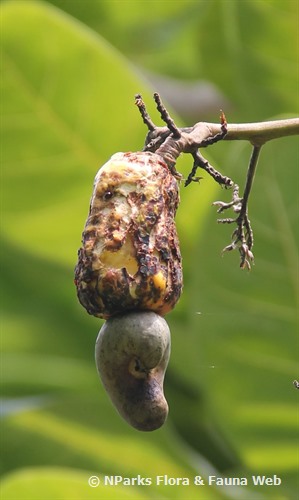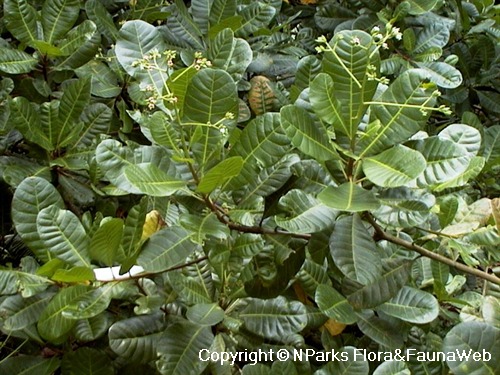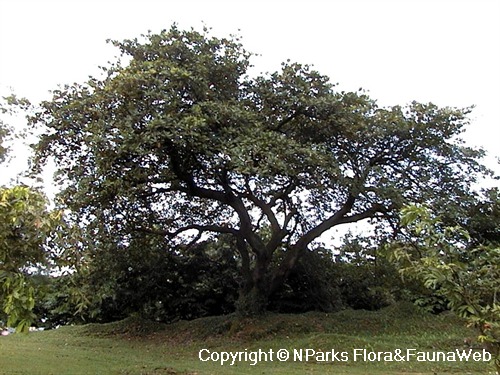.jpg)
Back
Anacardium occidentale
| Family Name: | Anacardiaceae |
| Common Name: | Cashew Nut, Cashew, Jagus, Gandaria, Gajus, Janggus, Jambu Gajus, Jambu Golok, Keterek, Terek, Jambu Bongkok, 腰豆树 |
Anacardium occidentale, commonly known as Cashew Nut, is a tree which can reach up to 12 m tall in the wild. Its seed is attached to a fleshy enlarged receptacle that is red or yellow when fresh. The seeds can be eaten after being roasted thoroughly.
Name
Classifications and Characteristics
| Plant Division | Angiosperms (Flowering Seed Plants) |
|---|---|
| Plant Growth Form | Tree |
| Lifespan (in Singapore) | Perennial |
| Mode of Nutrition | Autotrophic |
| Plant Shape | Rounded |
| Maximum Height | 12 m |
| Tree or Palm – Trunk Diameter | 0 to 1 |
Biogeography
| Native Distribution | Tropical America |
|---|---|
| Native Habitat | Terrestrial |
| Preferred Climate Zone | Tropical |
| Local Conservation Status | Non-native (Horticultural / Cultivated Only) |
Description and Ethnobotany
| Others - Plant Morphology | Up to 12m tall in height, this evergreen tree has a wide dome shaped crown and its foliage forms a thin peripheral canopy with protruding inflorescences (a flower cluster). Leaves simple and alternate. Flowers are in terminal panicles, about 10 – 20 cm long, male or female, green and reddish colour and are pollinated by honey bees, flies and possibly ants. Cross and self pollination occurs. Produced two fruits, the cashew apple and cashew nut. However, the cashew nut is the true fruit whereas the cashew apple is actually the swollen fruit stalk. Stem will ooze out a clear gum when injured.Anacardium occidentale can withstand dry condition provided that its extensive root systems has access to soil moisture. If planted at a dry area, a deep, well drained and penetrate-able soil is needed. Propagate by seed or grafting. Germination will start three weeks after sowing. Branches will soon emerge from the seedling stem and pruning will be required to attain a trunk height of 0.5-1.5 m. This juvenile period lasts for 3 to 4 years. Lower limbs (the lowest branches of the tree may reach 6 m or more in length and might be torn off during a storm.The new leaves grows in flushes and a major flush will follows the onset of the rainy season and within 3 – 4 months, an inflorescence will start to appear on many shoots. After 5 weeks, anthesis of the first flower occurs and over the next 5 – 6 weeks, further flowers (up to 1100) open up. Fruits will take two months to develop. It may have two flowering seasons when two distinct dry seasons occurs.Nut is usually roasted with oil before consuming. Cashew apple can be eaten fresh, mixed in fruit salad, and prepared a drink from the juice. Cashew wine, slightly fermented juice,can be distilled to produce strong alcoholic drinks.When doing weeding, cleaning the area within 1 m of the trunk and slashing out the remainder is important until the tree shade out most of the weeds.Anthracnose (Colletorichum gloeosporioides) attacks young shoots and flowers, under hot and humid condition, which dry up and are shed. Necrosis and shedding are the effects of the infection of fruits. It can only be controlled by removing and burning of infected parts.In cashew-growing areas, powdery mildew (white fungus growth) is common. Affected parts will be covered with white fungal growth and leaves may shrivel, dry up and be shed. Loss of flowers might occur as well. Sulphur will control the disease. Other fungi (damping off, wilts) have been recorded. Also, other local pests, e.g. wood borers, stem girdlers or sucking pests such as trip, may be destructive. |
|---|---|
| Ethnobotanical Uses | Edible Plant Parts : Edible Fruits Food (Fruit or Vegetable) Others: The cashew apple can be eaten fresh, preserved as jam or sweetmeat, mixed fruit salads and can be prepared as a drink. Cashew apple juice can be slightly fermented to become wine and can be distilled to produce strong alcoholic drinks. Both the fruit bark juice and the nut oil are said to be folk remedies for calluses, corns, warts, cancerous ulcers, and even elephantiasis. Poultry feeds are made from seed-coats. Cashew nut shell liquid (CNSL), an oil, is produced in large cells of pericarp. It also has industrial applications and can be used as a preservative to treat wooden structures and fishing nets. The wood can also be used as fuel or low quality timber. It is also used to produced charcoal. Tree bark is used in tanning. Extraction from the astringent barks has been used to treat severe diarrhea. Older leaves are used in the treatment of skin afflictions and burns. Oily substances from the pericarp are used to heal cracks in the feet. The bark is used to make herb tea to treat asthma, colds and congestion. Seed oil is used in the treatment of gingivitis, malaria, and syphilitic ulcers. Bark and leaves are used to treat sore gums and toothache. The extraction of the leaves is gargled to cure sore throat. The resin is used for cold treatment. |
Landscaping Features
| Landscape Uses | Coastal, General |
|---|---|
| Thematic Landscaping | Economic Garden, Naturalistic Garden |
| Plant & Rootzone Preference or Tolerance Remarks | Can tolerant dry condition as long as the root system have access to soil moisture. |
Fauna, Pollination and Dispersal
| Pollination Method(s) | Biotic (Fauna) |
|---|---|
| Seed or Spore Dispersal | Biotic (Fauna) |
Plant Care and Propagation
| Light Preference | Full Sun |
|---|---|
| Water Preference | Moderate Water |
| Plant Growth Rate | Moderate |
| Rootzone Tolerance | Well-Drained Soils |
| Diseases | Anthracnose (Colletorichum gloeosporioides) attacks young shoots and flowers, under hot and humid condition, which dry up and are shed. Locally, other pests, e.g. wood borers, stem gridlers or sucking pests such as thrips. However, such diseases and pest are seldom of economic importance. |
| Propagation Method | Seed, Grafting |
Foliar
| Mature Foliage Colour(s) | Green |
|---|---|
| Leaf Area Index (LAI) for Green Plot Ratio | 3.0 (Tree - Intermediate Canopy) |
Non - Foliar and Storage
| Root Type | Underground (Tap Root) |
|---|
Floral (Angiosperm)
| Flower Lifespan on Plant | Several Weeks |
|---|---|
| Flowering Habit | Polycarpic |
Image Repository
Others
| Master ID | 1416 |
|---|---|
| Species ID | 2709 |
| Flora Disclaimer | The information in this website has been compiled from reliable sources, such as reference works on medicinal plants. It is not a substitute for medical advice or treatment and NParks does not purport to provide any medical advice. Readers should always consult his/her physician before using or consuming a plant for medicinal purposes. |

.jpg)
.jpg)
.jpg)






